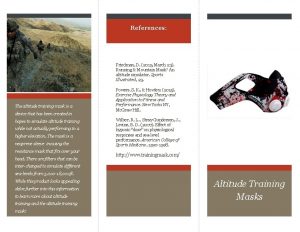References The altitude training mask is a device


- Slides: 2

References: The altitude training mask is a device that has been created in hopes to simulate altitude training while not actually performing in a higher elevation. The mask is a neoprene sleeve incasing the resistance mask that fits over your head. There are filters that can be Friedman, D. (2015, March 23). Running & Mountain Mask? An altitude simulator. Sports Illustrated, 23. Powers, S. K. , & Howley. (2015). Exercise Physiology Theory and Application to Fitness and Performance. New York: NY, Mc. Graw Hill. Wilber, R. L. , Stray-Gundersen, J. , Levine, B. D. (2007). Effect of hypoxic “dose” on physiological responses and sea-level performance. American College of Sports Medicine, 1590 -1598. http: //www. trainingmask. com/ inter-changed to simulate different sea-levels from 3, 000 -18, 000 ft. While this product looks appealing delve further into this information to learn more about altitude training and the altitude training mask! Altitude Training Masks

Altitude Training "Live High Train Low": • Increase buffering capacity • Improve mitochondrial function • Increase in red blood cell mass “I put the mask on, and I probably did a lap around the building where we train, and halfway through the lap, I had to take it off and stop. Three days of working out with it, my wind go that much better. I just get my mask on, and I get my little boost like-” - Marshawn Lynch- NFL Training Mask Benefit Claims: • Increase lung capacity • Increase surface area & elasticity of alveoli • Increase anaerobic threshold • Increase VO 2 Max • Strengthens the diaphragm • Increase serum EPO • Conditions the lungs by creating pulmonary resistance • Decrease workout time In order to seek the physiological adaptations that occur with altitude training several hours a day need to be spent in high altitude at least 4 x/wk. It has been found that the optimal sealevel range is 2000 -2500 m (Wilber, Stray-Gundersen, Levine). If athletes train in lower altitudes then they are less likely to experience the negative effects that can result from training which includes mountain sickness, potential decrease in VO 2 max, & decreased cardiac output (Powers & Howley, 2015). A physician was interviewed for the article by the name of Michael Ross, he stated that the altitude advantages that elite athletes get from altitude training come when prolonged periods of time are spent in those conditions. He also concluded on the product specifically that there are dangers when using the mask that have no been addressed such as athletes or individuals that might have a heart condition should not be using the product (Friedman, 2015). While all the above benefits are desired outcomes for performance enhancement; research has yet to be conducted that validates these results. A Dr. Artour Rakhimov is cited on the websites page, however no research studies are linked to him and the mask. From this website it is clear that studies need to be conducted to strengthen the claims of this product.



